Is the New Budget DS220j NAS from Synology Worth Your Data?
For those of you that have been waiting for news on a new Synology 2-Bay network-attached storage (NAS) device, it has certainly been quite a wait. With the 2017/2018 series of devices now over two years old, despite the constant improvements in DSM, it has seemed like a long old wait. Alongside this, we have seen news and releases into the 2020 series of devices gracing almost every other range (DS620slim, RS820+, DS1620xs to name ut a few), but still no two-bay NAS devices – till now. The Synology DS220j NAS is a device squarely aimed at the budget buyer and for those looking to make a tentative step into the world of a more value-based network storage solution. Whether it’s because they are moving away from the cloud due to subscription costs (DropBox, Google Drive, OneDrive, etc), are looking for something more centralized and secure, or are simply looking for a means to add another layer to their backup solution – the DS220j is presented as a solution to a number of low-level data problems. I use the term ‘low level’ because it would be remiss of me to suggest that the DS220j is a ‘Powerful’ device or something that going to give you the premium Synology experience, no, and I cannot review it as such. The £125 (ex.VAT) DS220j arrives as a more cost-effective and value solution that arrives at 40-50% lower in price than established/powerful devices like the DS218+ (or DS220+ eventually) and this needs to be taken into account. Has Synology mastered the balance of price vs power in this new NAS? Does it deserve your data? Let’s find out.
Synology DS220j NAS Drive – Quick Review
Synology DS220j NAS Drive – Packaging
Unsurprisingly, the DS220j arrives in a fairly plain and non-description box. The retail packaging for NAS drives has rarely challenged the norms of more technical hardware and 2020 only seems to solidify this fact. The reason for this is two-fold. Firstly, the manufacturing costs and in house design of a product needs to be fairly uniform in most big brands and Synology is no exception. The other, more pertinent reason, is because the majority of NAS buyers will do so via an online shopping platform these days – NAS is not much of a highstreet device outside of more technical retailers. consequentially, the traditional draw of flashy and graphical retail packaging is largely redundant when the first time the end-user will see it, is AFTER they have purchased and received it.
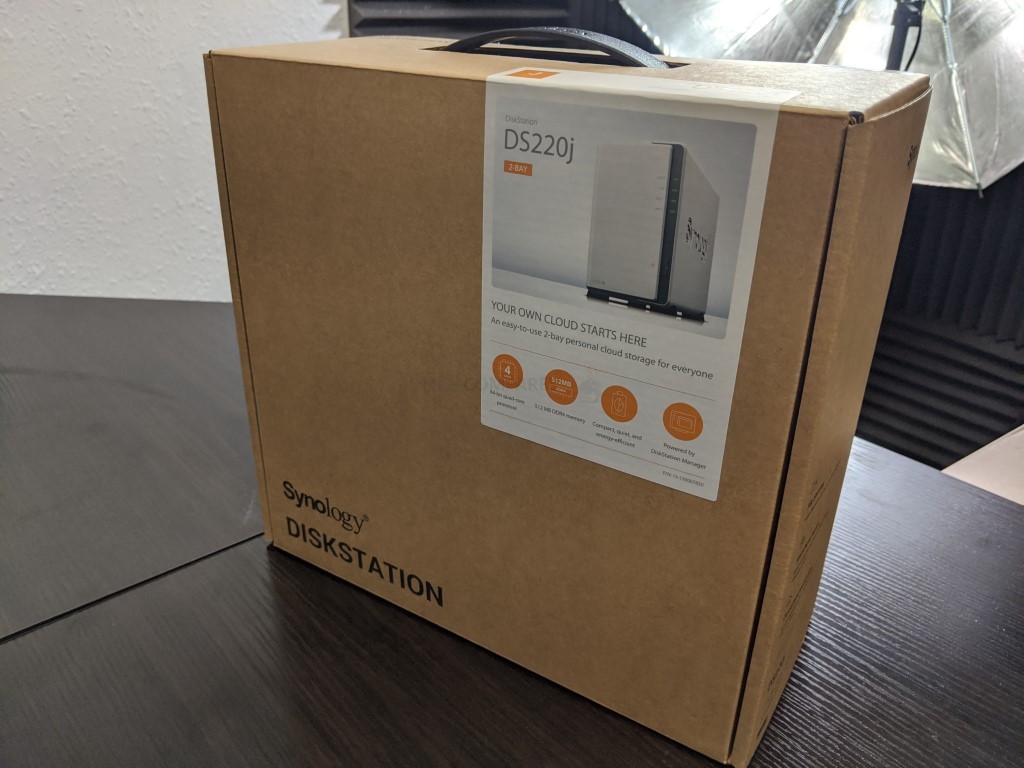
So, instead of focusing on the external retail design, let’s focus a little bit more on the structure of that packaging, as in a much online-shopping focused world – transit protection is way, WAY more important. I am pleased to say that despite its rather modest-sized retail box, the structure of the retail kit is impressively robust. With each part of the kit neatly held in place and displayed well.
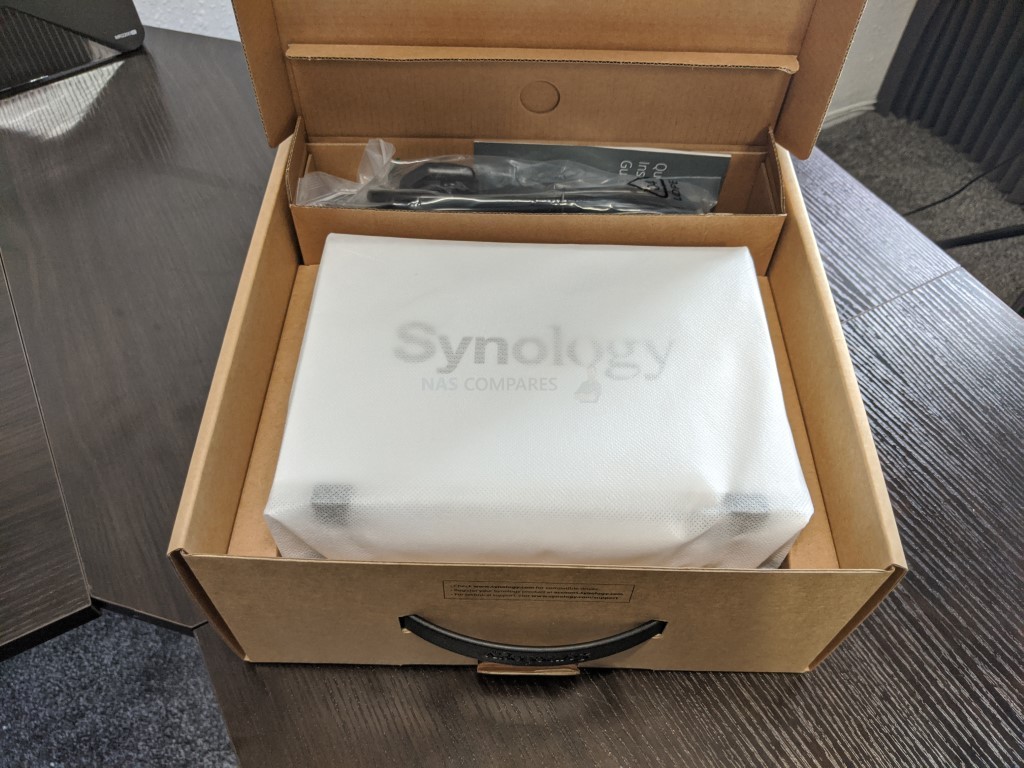
Once I got the DS220j out of it’s retail packaging, I could get to see what £125+ buys you in NAS in 2020 (not including the media or the tax of course.
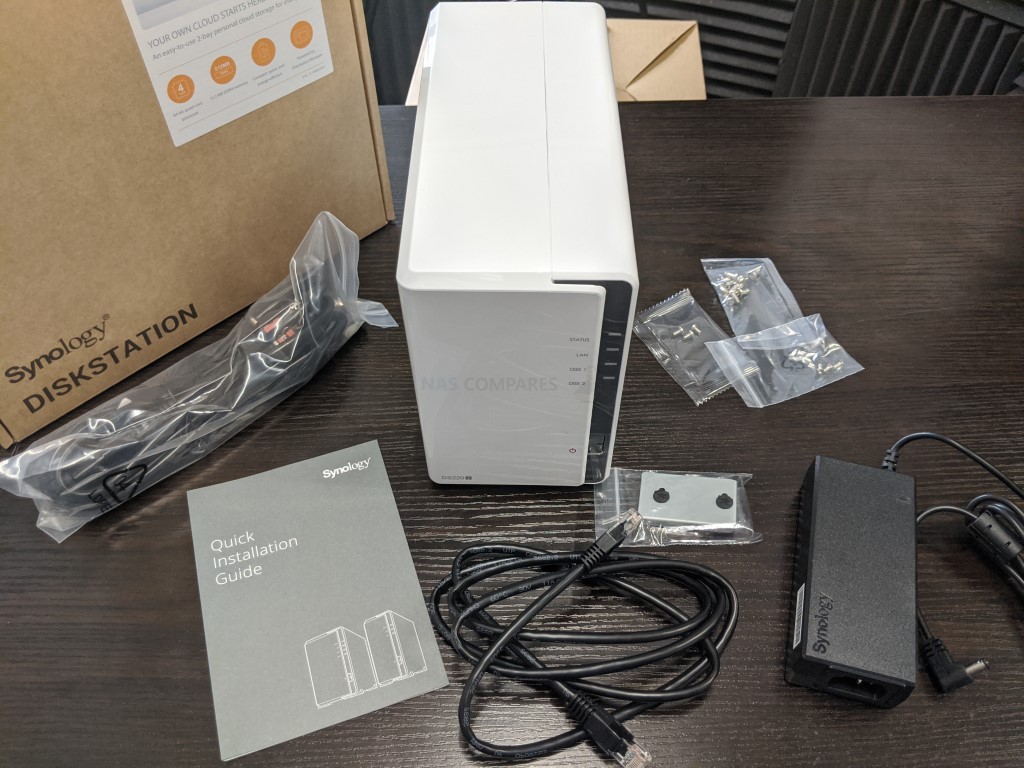
The DS220j NAS arrives with numerous screws for installing HDDs and the external chassis frame, as well as a metal bracket and further screws for installing two drives into the frame (I will cover this a little more later), along with an instructions manual, 1Gbe class RJ45 LAN cable and an external 60W PSU. This is all fairly standard kit for a diskstation NAS and pretty much everything you need (apart from an HDD/SSD of course) to get this device up and running in your home and business. But I did want to take a closer look at the Power supply unit.
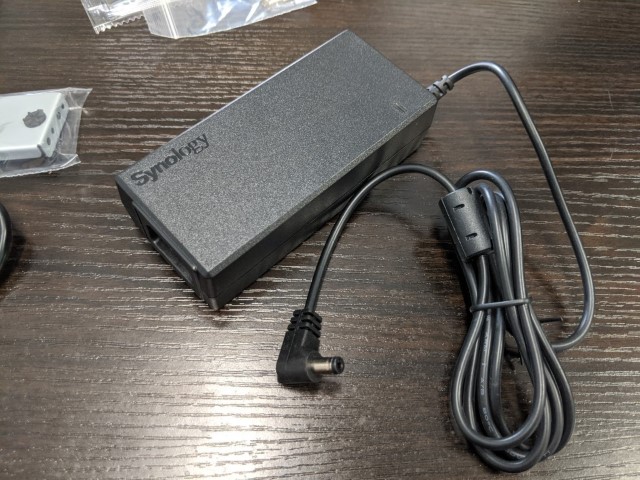
This 60W external PSU is branded, very small and pretty discreet. The DS220j is not designed to be exhaustively power-hungry and it will be close to impossible for a conventional user to use the lion share of the power draw from that PSU to operate. Synology themselves highlight that it was recorded (whilst using two Western Digital 1TB WD10EFRX WD Red Hard drives) at 12.46W (whilst in access) and 5.06W ( whilst in standby / hard drive hibernation). There are mixed feelings about external PSUs in storage devices, with some users preferring internally installed PSUs. I think that desktop NAS benefit from external PSUs overall, because despite the possible ‘trip on a power cable’ or ‘moving the cable falling out’ issue (1 – why are you that close to the NAS / Moving it when it is on!, 2 – Still applies to internal PSUs), an external PSU is about 500% easier to replace and swap out than an internal PSU on a desktop NAS device that is designed to be compact.
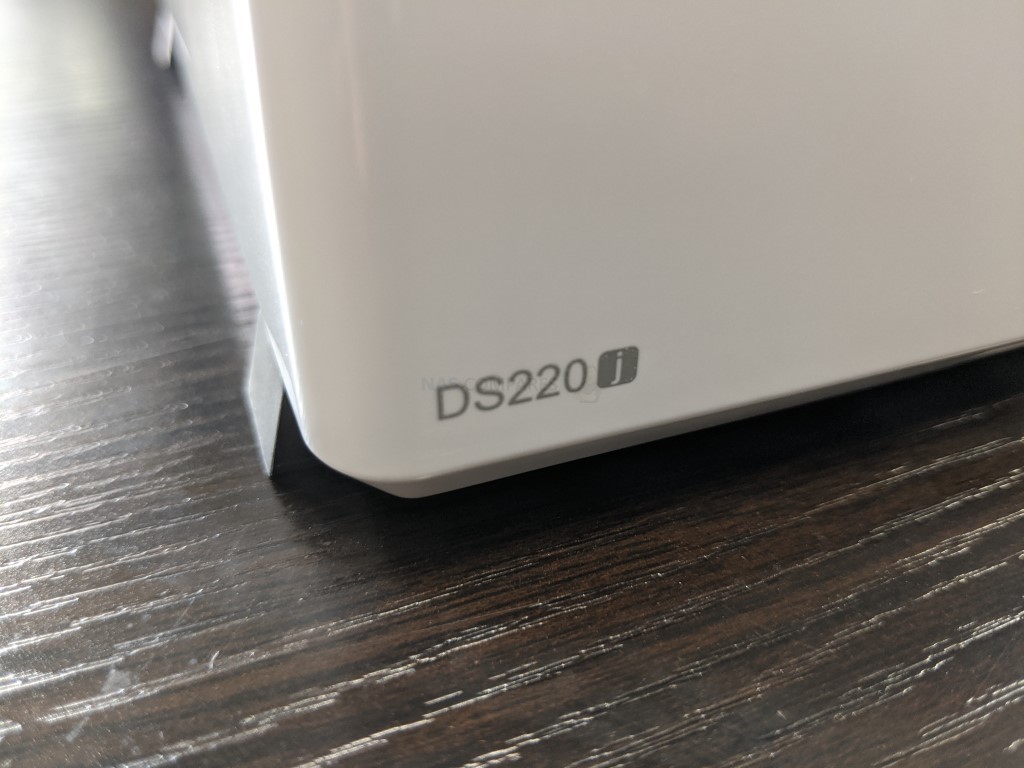
Overall, I am pretty happy with the overall presentation of the DS220j NAS kit, but let’s see what Synology has done with the hardware design of this NAS.
Synology DS220j NAS Drive – Design
For those that are largely unfamiliar with the 2-Bay J series from Synology, the DS220j is a very different design path when compared with plus series units or larger bay devices. For a start, the device does not feature hot-swapping of storage media or bays to do it. The device is a largely closed system when in operation and requires a complete power down if you want to add another drive. The DS220j can operate with a single HDD/SSD installed but works at it’s best when you have two drives inside in a RAID 0 (combined), RAID 1 (mirror) or SHR (Synology Hybrid RAID for flexibility).

Arriving at 16.5cm x 10cm x 22.5cm and just 950grams (including a PSU) when unpopulated, this is a remarkably compact NAS device, even with two bays of storage inside. This chassis differs in a few areas with bigger and more expensive NAS in that the casing is almost completely plastic (with a metal framework inside), no USB Copy button support or trays available. Things are kept remarkably streamlined (a word you will hear alot in this DS220j review) and discreet to a pleasing degree.
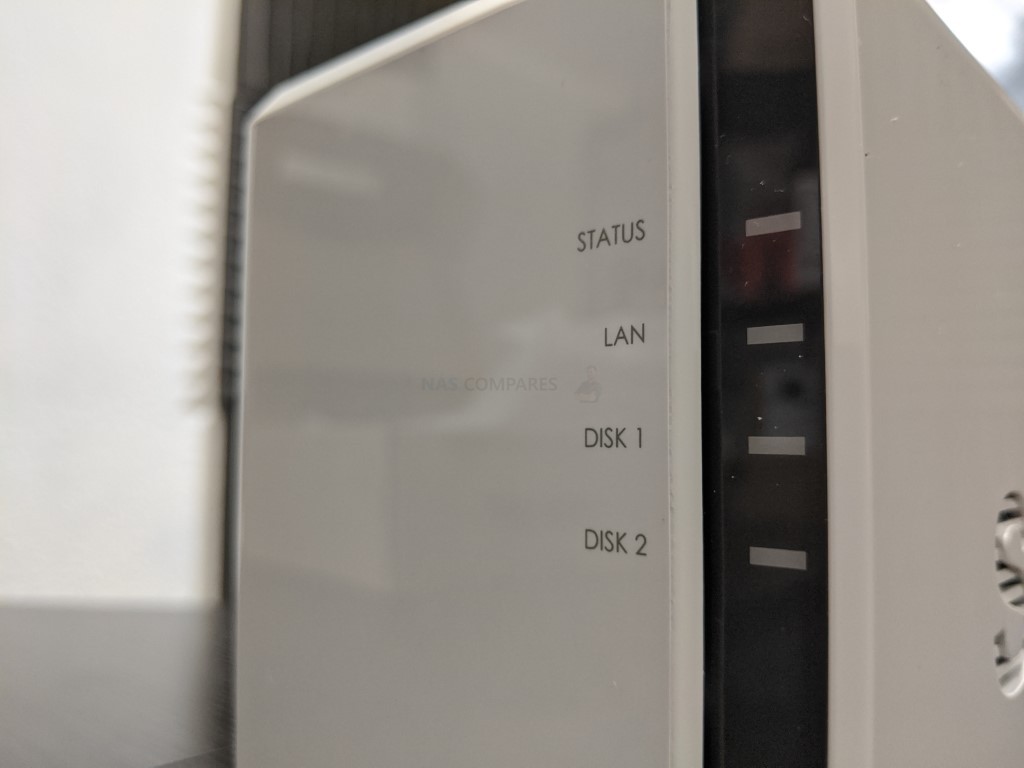
Instead of an LCD display or screen, the DS220j is much like other Synology NAS and features multiple LEDs for realtime information on your storage device when viewed at a glance. Obviously this is pretty sparse, but then it does not need to be hugely detailed at this level. Synology as a brand has never moved into digital displays of information, almost exclusively favouring network/internet access only with web browsers and client apps for many platforms.
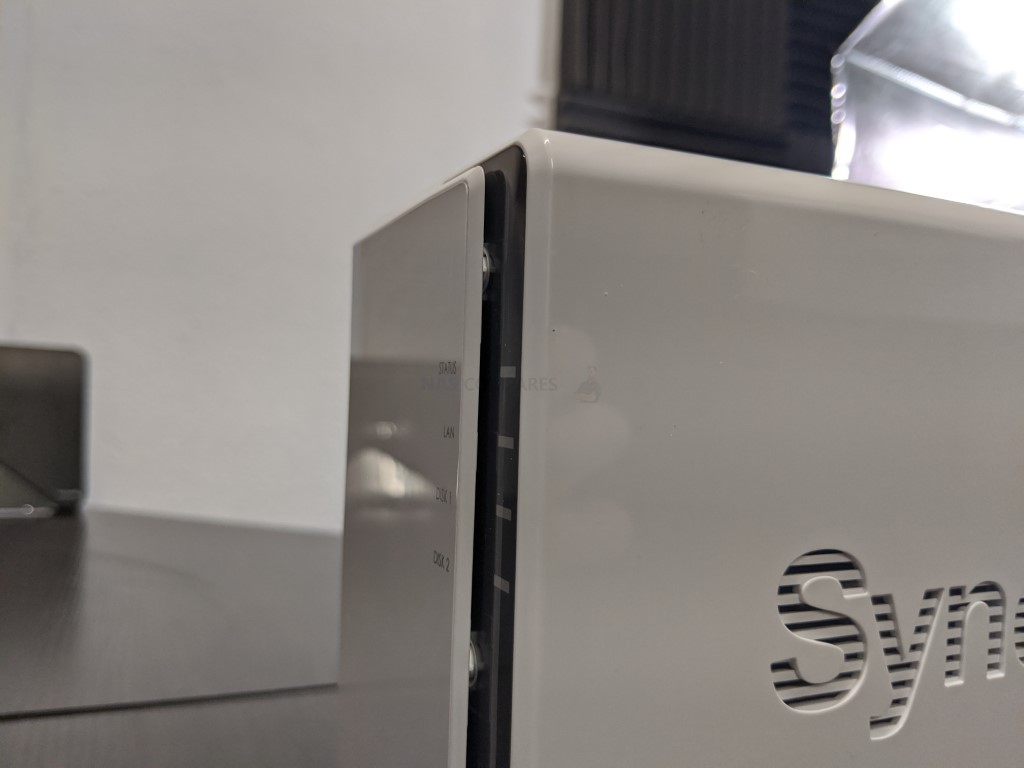
The remarkably slim chassis does feature numerous areas of passive ventilation around the device (assisting an active cooling system we will touch on later) and I have to give them credit or this, as it does mean that the device with its plastic chassis and multiple cooling systems can maintain a very low noise level when in operation.
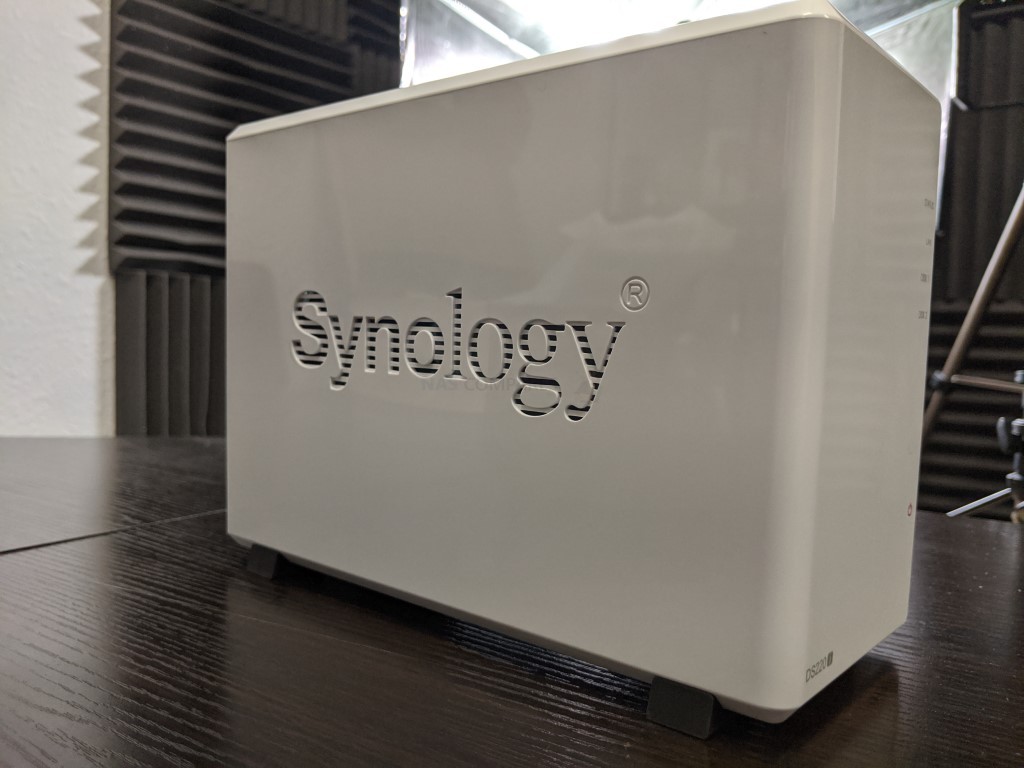
Sticking on the subject of cooling, another Synology NAS constant is the use of their logo on either side of the DS220j diskstation chassis as a ventilation panel. This is actually really cleverly done and despite this being the 4/5th generation of Synology NAS I have seen do this, I am always impressed by the design angle.
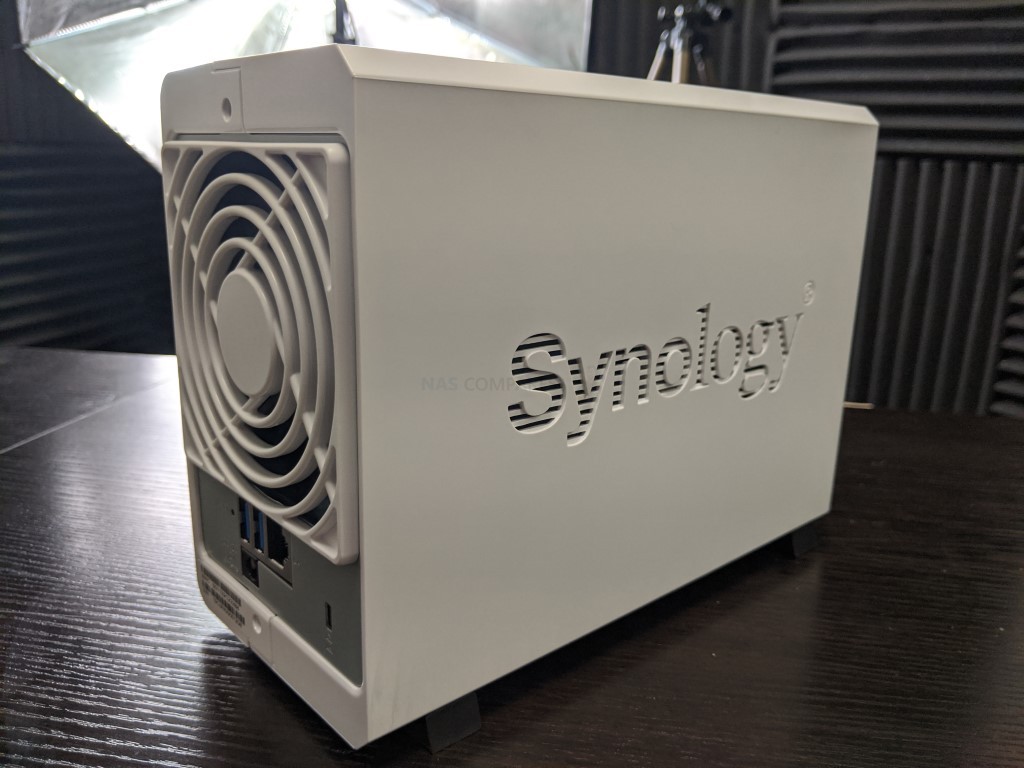
If you look at the base of the DS220j NAS chassis, we find four rubber feet and even more ventilation. As you can see from the chassis, despite it being a 2-Bay NAS casing, it still remains very small.
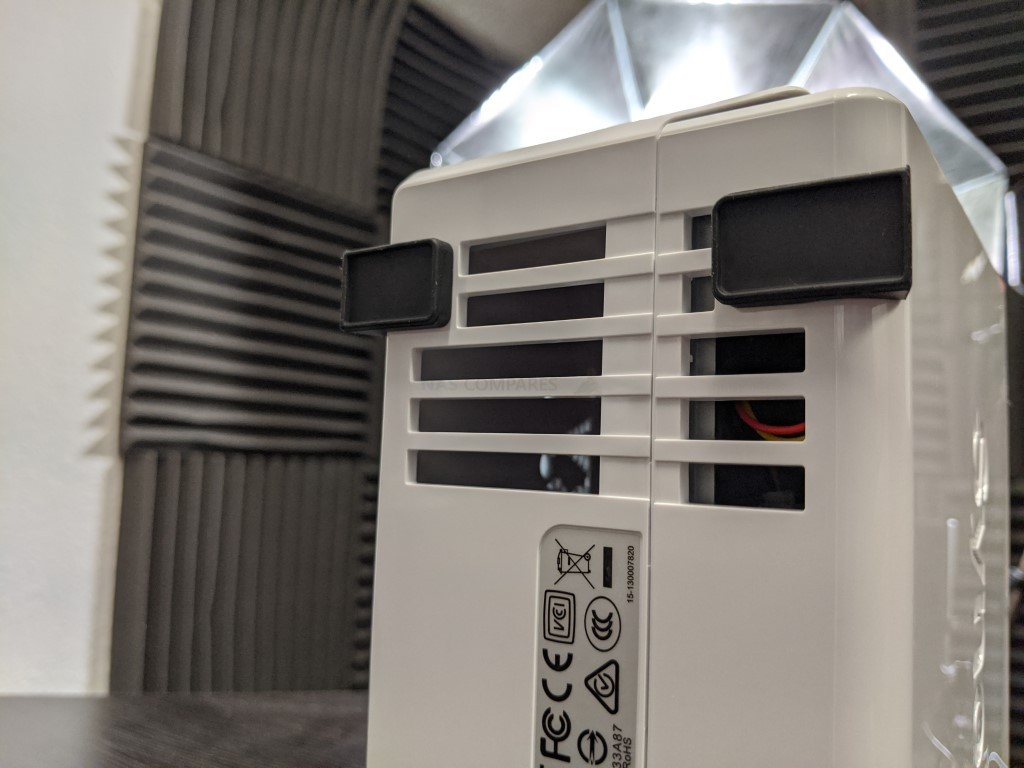
Overall, I like the design of the DS220j NAS. It is starting to seem the tiniest bit old now and I think perhaps the DS420j and DS220j NAS casing could do with a revision in the next generation (as we saw in the DS918+ and DS218+ in the previous generation), but it’s pretty competent and whilst still doing everything that it needs to, does it with the minimum of fuss even at this price point.
Synology DS220j NAS Drive – Connections and Ports
As you would expect from a NAS targetted at cost-effective and ‘value’ targetting buyers, the Synology DS220j is not trying to reinvent the wheel! We have seen a surge in multi-gigabit technology in the last 18 months, with 2.5Gbe and 5Gbe often arriving in bigger NAS releases at a price point very close to that of 1Gbe. Likely 10Gbe, though more expensive than 1Gbe, is CONSIDERABLY lower in price than it ever has been (at around 3x the cost of a 1Gbe solution). Consequently, the DS220j may well be the last time we see a 1Gbe budget NAS solution from Synology, at least in the J series for this generation.But let’s look a what is on offer here.
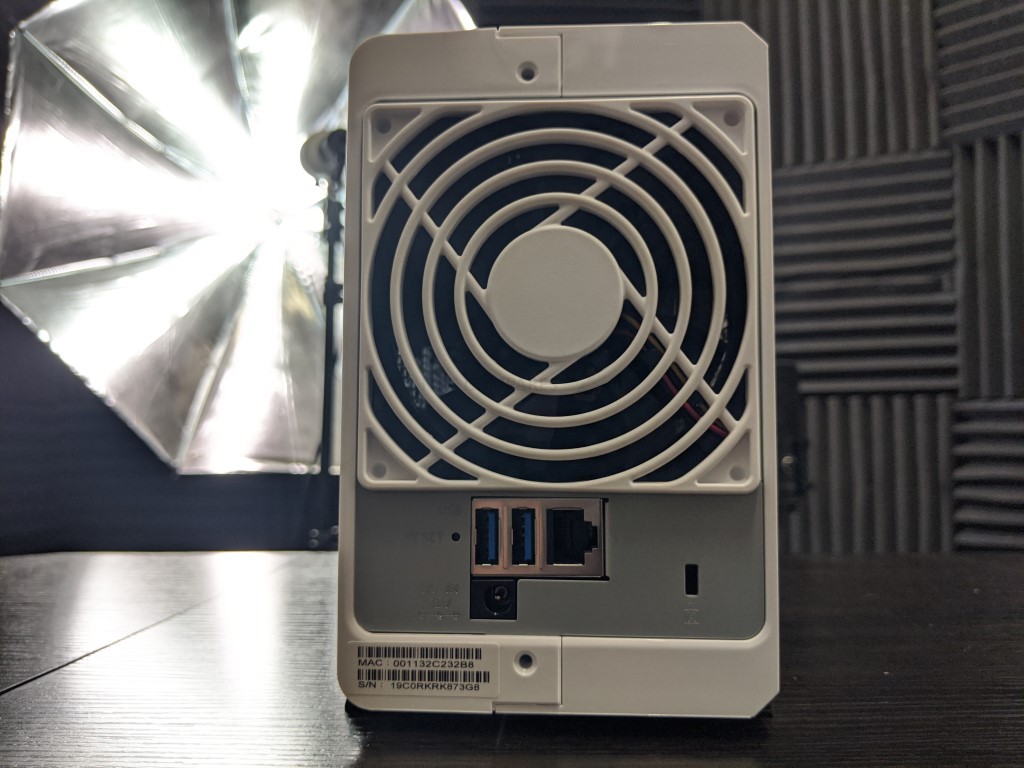
The ports have changed very little since the predecessor to the DS220j, the DS218j. Near identical, in the majority of ways, the DS220j Synology features multiple USB ports and a network connection.
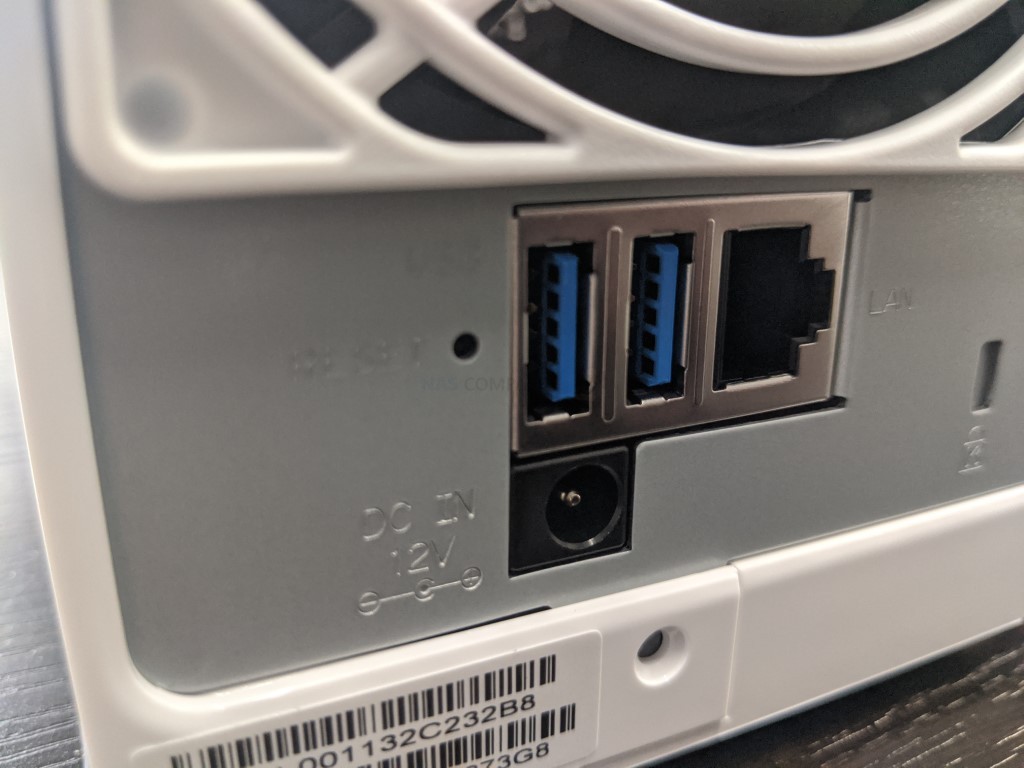
The USB ports are actually still a welcome addition. Despite growing trends in ethernet connections on modern NAS devices, we are still seeing devices arriving with USB 2.0?! Yes, the manufacturers do claim that there are still numerous peripherals that do not take advantage of USB 3.0/3.1/3.2 and therefore do not need it, but I refuse to accept in 2020 that swapping out ports from 3.0 to 2.0 actually saves THAT much power or has THAT MUCH of an impact of power consumption overall. That is why I am pleased to see two 5Gb/s USB 3.0 ports on the DS220j Synology NAS – it’s an area they COULD have cheapened out on, but didn’t.
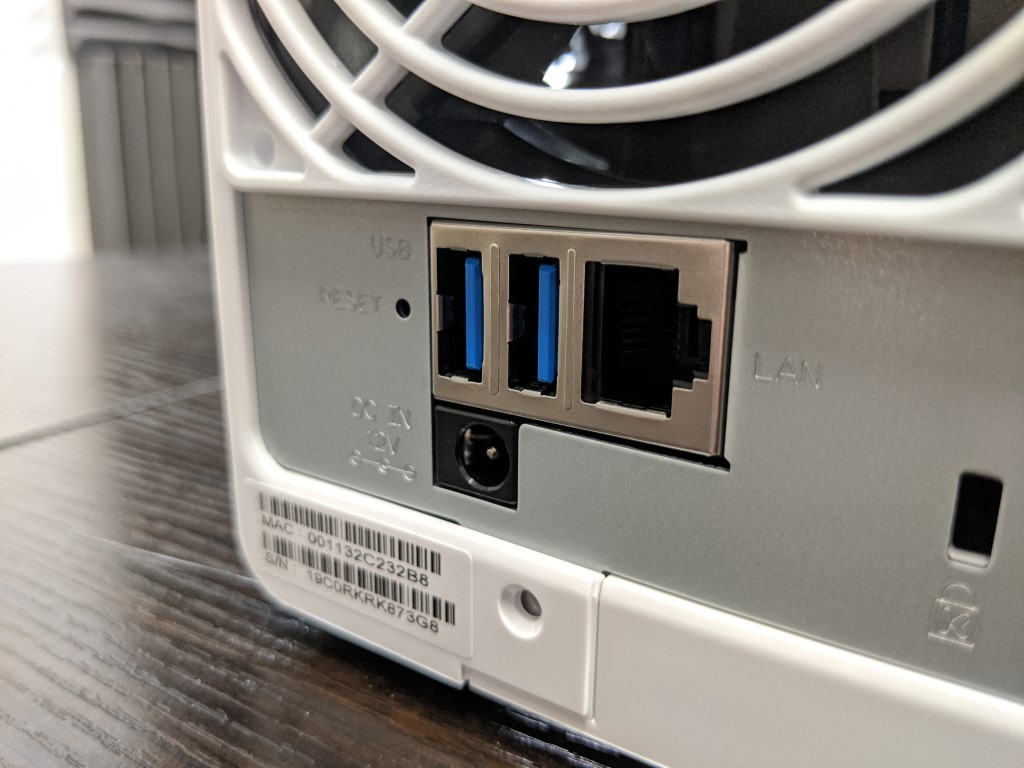
As mentioned, the DS220j is a 1Gbe NAS, resulting in a max transmission speed of 100-110MB/s in the perfect scenario. This port can be used to connect the DS220j to the internet via modem or switch, or directly (cable to cable) via the RJ45 connections to a PC/Mac system. The NAS is not typically designed for this kind of connection, but it is still a means of access many users use who want to use the NAS drive and it’s storage in a 1-to-1 capacity, without internet connectivity. For many, a NAS is at it’s most secure when used in this way – a never would, but everyone’s different!
Performance is pretty solid, thanks to that Realtek 64bit processor inside and despite the modest 512MB memory, it can still maintain over 100MB/s read and write in mid-range storage scenarios and exchanges. Of course, these will depend a great deal on your storage setup and even more on how many users are connected at a single time, but it is good to see a 2-Bay J Series NAS hit that full bandwidth in ways the previous units clearly struggled.
Even with hardware encryption (AES 256bit) enabled, we can still see decent speeds being provided. These did seem to decrease once the quantity of files increased, as appose to single BIG files being tested, but even then we saw read at 80MB/s+ and Write at 60MB/s – again, pretty good for a budget solution.

Whilst the unit is in operation, Synology highlight that with 2 Seagate Ironwolf hard drives installed in a RAID 1, noise levels were pretty low at 18.2 dB (A). This will massively depend on the hard drives you choose to install when using the device, as more enterprise-level drives do tend to make more clicks/hums/vibrations overall, but the device itself, with it’s combination of passive cooling, plastic chassis and compact frame all help to keep this 2-Bay NAS pretty unnoticeable in your hardware environment.
Synology DS220j NAS Drive – Internal Hardware
Accessing the internals of the Synology DS220j NAS is a fairly simple affair. As mentioned, this NAS does not feature removable trays, so in order to access the media bays of the DS220j for the first time or to upgrade the drives, you need to power down the device, then remove two screws on the rear of the NAS.
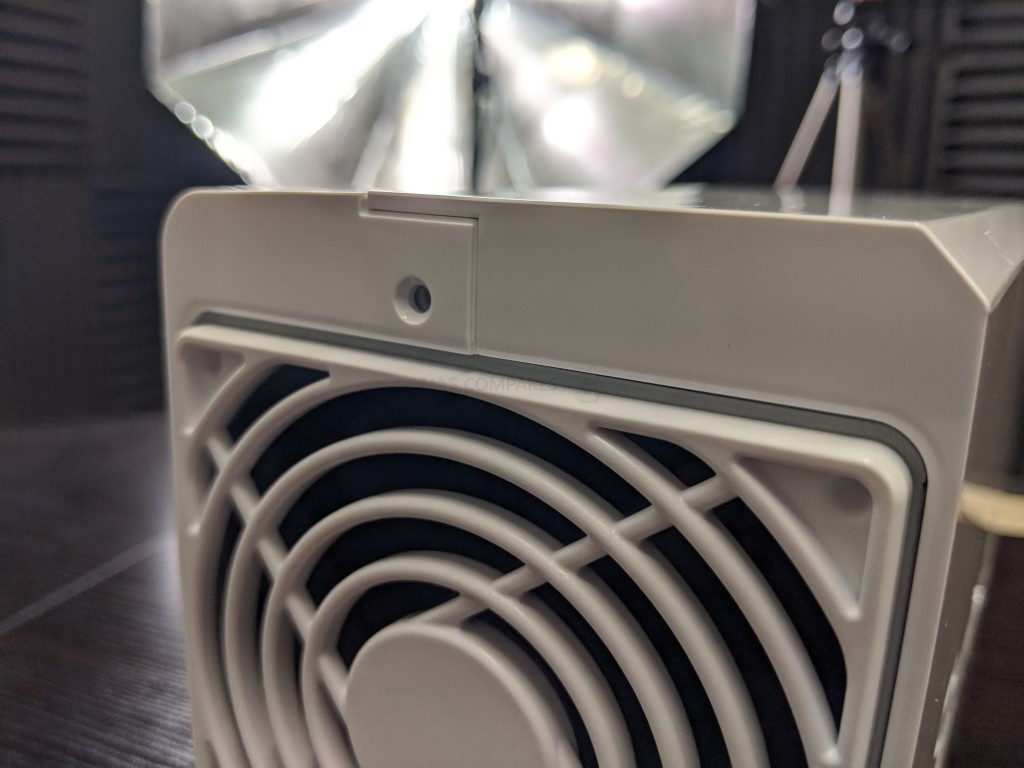
Once they have been removed, you are able to slide one half of the chassis off and it will expose the metal framework inside along with the means with which you can install drives inside the DS220j NAS.
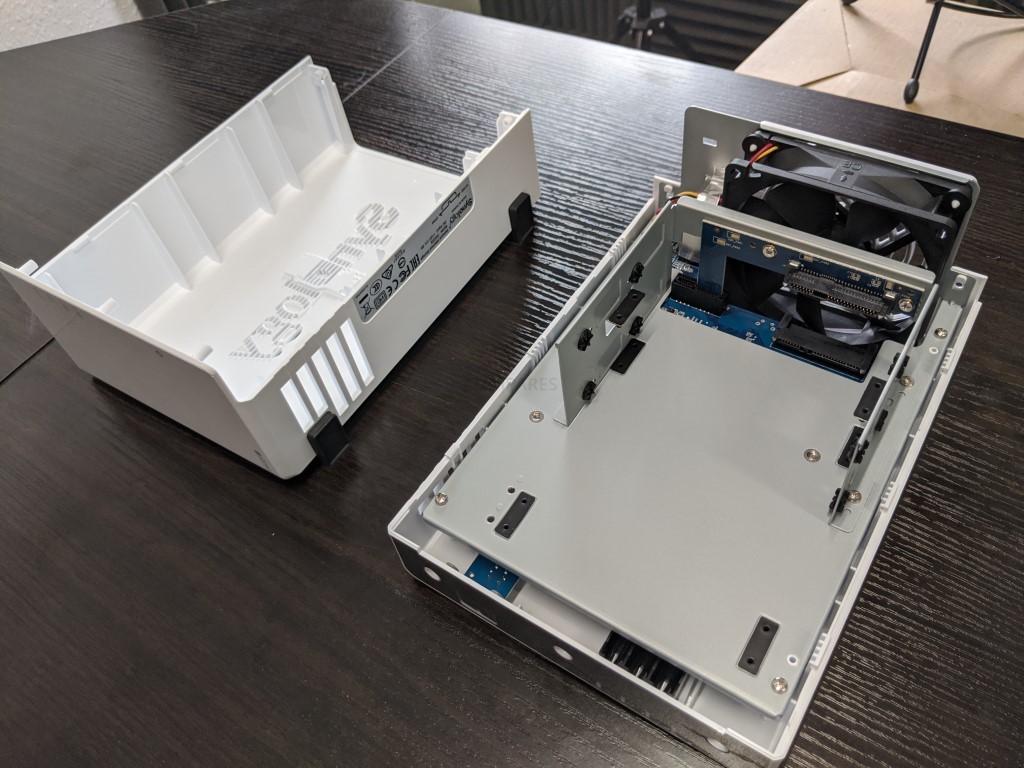
It is not the most elegant affair when compared with more expensive NAS with dedicated HDD/SSD trays and hot-swapping enabled, but it is still very functional and many might argue that having to do this once or twice in the entire lifespan of the DS220j NAS is worth it to save a few quid on a Synology NAS drive. The bays that the HDD/SSD SATA media sits in are a little bare, with screw holes for mounting the HDDs, the DS220j supports the very latest 16TB Seagate Ironwolf and 14TB WD Red hard drives, so you have a huge amount of storage potential, even in a budget NAS like this. That said, I am amazed that this style of HDD installation has not be overhauled in the latest generation of the 2-Bay J series. It is just too fiddly, does not support 2.5″ media appropriately and adding a couple of plastic trays to attach drives into, then slide into each groove (as found in the 4-Bay budget NAS DS420j) is a little lacklustre and lazy. Seems like they just relied on the existing chassis a bit too much over the years and is another area that I highlight to argue for a redesign in the next generation.
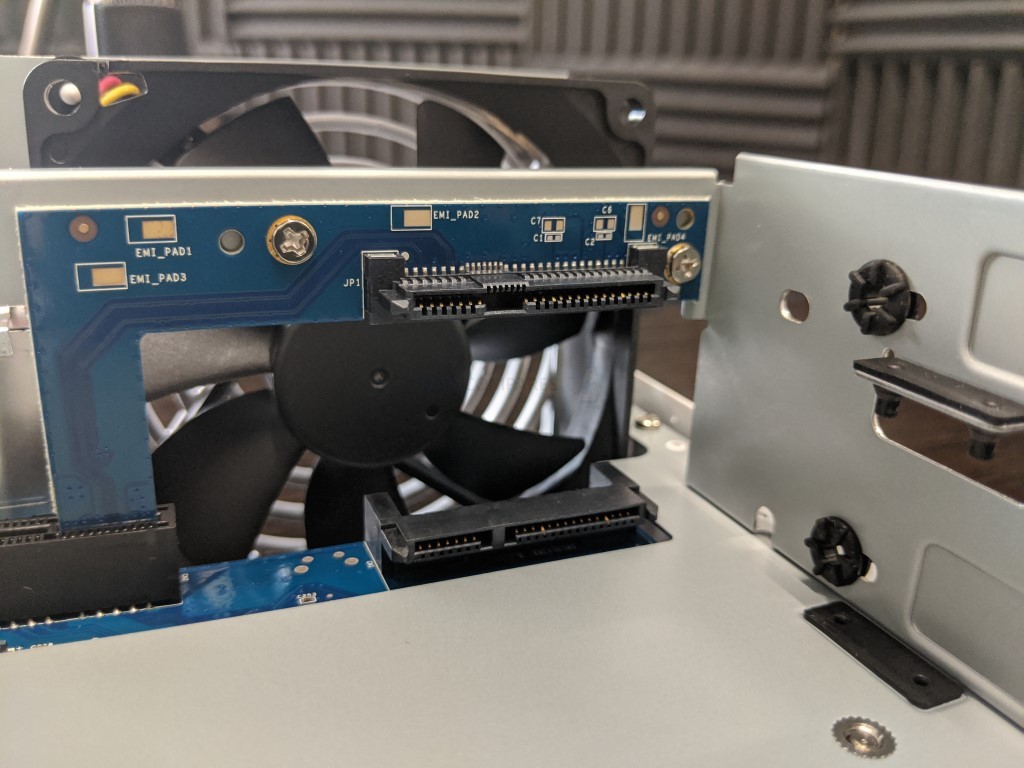
Each Bay is pretty large and the HDD media is screwed in at 4 points directly into the frame. This does reduce some of the noise whilst the device is in operation, but it will also mean that those larger capacity drives (that are built in a much more industrial fashion) will resonate any vibrations throughout the metal internal frame quite a bit – another area where a well-designed tray and cushion system found on bigger and more expensive NAS drives than the DS220j has featured. Each drive will connect into their own dedicated SATA port inside the DS220j, which means no fiddling with cables or power connectors. Additionally, the RAID configuration and setup is software-based and conducted in the DSM software setup and storage manager, so no messing with RAID switches like the old days! The Internal hardware of the Synology DS220j is actually rather familiar. That is because it is remarkably similar to that of the DS420j 4-Bay NAS drive released just weeks ago. Arriving with a Realtek RTD1296 4-core processor, this new 2-Bay J series NAS arrives with a very good ‘efficient’ CPU. This processor is backed up with some DDR4 memory support, much like the predecessor. However, it arrives with just 512MB – which although the same in quantity as the DS218j, is still a rather small amount, especially given the potential of that Realtek 64bit ARM CPU. I will go into a little more detail later, but there is no avoiding that this half a gigabyte of memory certainly serves as a massive bottleneck to your future if you expand your data usage down the line.
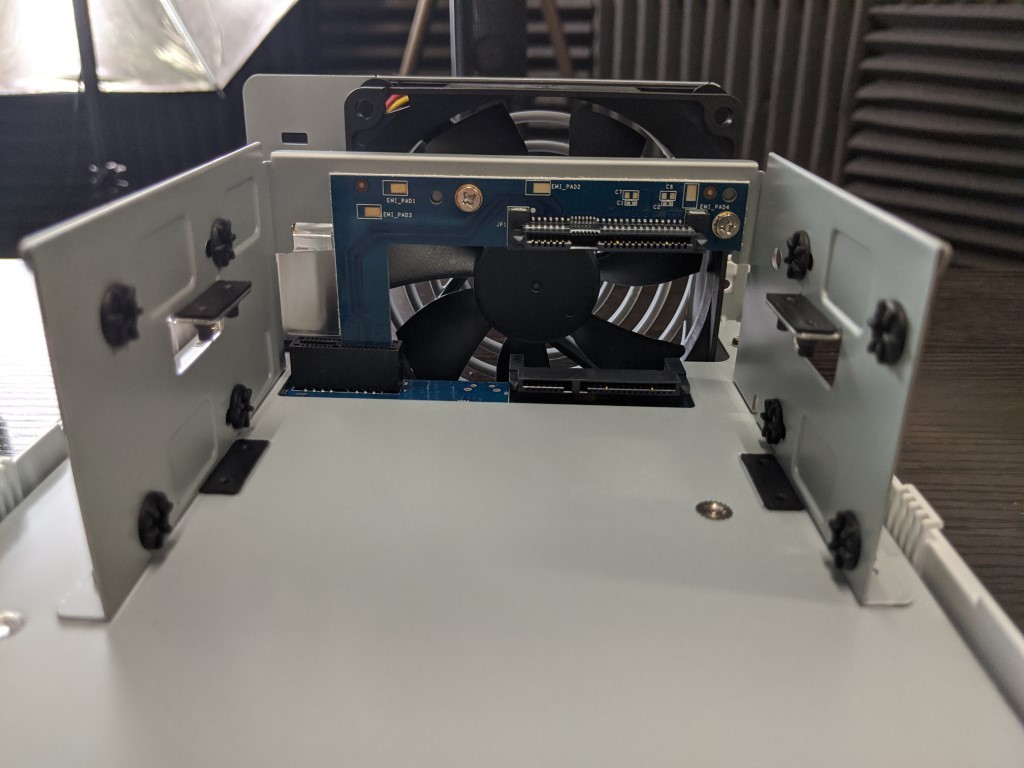
That memory cannot be upgraded and although it arrives as a great base with which to being your Synology NAS user experience when your libraries of data and services on the DS220j NAS are better established and being accessed by multiple client devices, that 512MB of memory will result in slowing access by multiple users at once, Surveillance camera use and more. If you are a home user looking to create some low key (non-mission-critical backups) or stream multimedia to your home consoles and TVs, it is a great choice.
Synology DS220j NAS Drive – Software
The DS220j NAS arrives with the popular Synology GUI and operation platform, disk station manager. This operating system arrives with many, many applications available for free download once the DS220j is setup. Alongside this, there are client applications for PC/Mac systems, as well as mobile applications that suit many needs of data types for iOS and Android. Let’s talk about how that internal hardware mentioned earlier of the Synology DS220j 2-Bay NAS impacts the individual Synology NAS software in DSM 6.2. Because of the remarkably affordable price tag of this device, the internal hardware is pretty low compared with modern standards and although it is 100% better than DS218j in terms of the CPU (with 4 cores compared with 2, and at 64bit in architecture), it arrives with the same small memory (albeit DDR4 vs DDR3) memory which cannot be upgraded. That means that in general terms compared with other Synology Plus series NAS, this diskstation is designed to be economical in more than just the price tag. That said, I was still very surprised at the number of apps that is did arrive with:
It will certainly support features and functionality such as DLNA media playback too network devices, multiple backups from PC/Mac systems, multi-user file access and sharing folders. It even supports desirable Synology first-party apps such as Synology Drive, Synology Moments (particularly impressed by that one) and even surveillance station, supporting upto 12 Cameras at once. Synology J series NAS drives were never designed to completely show off everything a Synology NAS can do and the DS220j is not going to be your powerhouse NAS solution. It is designed to work as your entry point into NAS, as a low-end RAID/SHR enabled, data sharing solution, or as a network backup to an existing network storage setup in the background. Typically with this Realtek 64bit CPU, we have seen quite alot of potential. When this RTD1296 CPU has been featured on previous NAS drives from Synology (the DS418, DS218, DS819 to name a few) we have seen it support Plex Media server, 15-20 cameras in Surveillance station, BTRFS as a file system, 4K Support and more. However, this it is a VERY DIFFERENT story with the Synology DS220j, as that low memory DDR4 limit (especially for 2020 when mobile phones measure their memory in gigabytes) is going to prevent a number of these software packages being able to run.
You will get a good base level experience in DSM 6.2 (and no doubt in DSM 7.0 later), but the fact the DDR4 memory cannot be expanded (you cannot even reach the module and consider swamping anything out without significant disassembly, MASSIVELY voiding your warranty) is something that will result in your usage of the device for multiple users/devices/applications at once hitting ‘99% Memory Usage’ happening sooner than you would like. Additionally, the fact that this also resulted in alot of the cool things this CPU can do being nerfed (BRTFS, 4K Transcoding, etc) means that by its very design, you have a DSM experience that has been streamlined because of a simple drop from 2GB to 1GB, to 512MB of memory – which in terms of production costs is fantastically small, serving you to feel like this was an intentional move to keep product families separate. All this aside, if you are a home user, small shop owner or a business looking for central backups and shares that are not going to be fantastically taxing, the DS220j NAS Software support will certainly do the job.
Synology DS220j NAS Drive – Review Verdict
What I hoped would be a NAS that kicks off the new 2-Bay range from Synology for 2020, does so with reasonable success. I cannot say that I am not impressed by the hardware here at this price – the specifications for this £125+ NAS (ex.VAT) is genuinely impressive and much, much more than all the other 2-Bay J Series Synology that have come before it – in that way, the DS220j is a flat out winner! It gives you a great baseline experience of DSM, at a price point that is low enough to hook you in at the low level, but still not too expensive that you will feel bad if you want to upgrade sooner than you would have liked! Plus, the new and old NAS can be used to synchronize and add to your backup strategy, so in that way, the DS220j is genuinely unbeatable in it’s field.
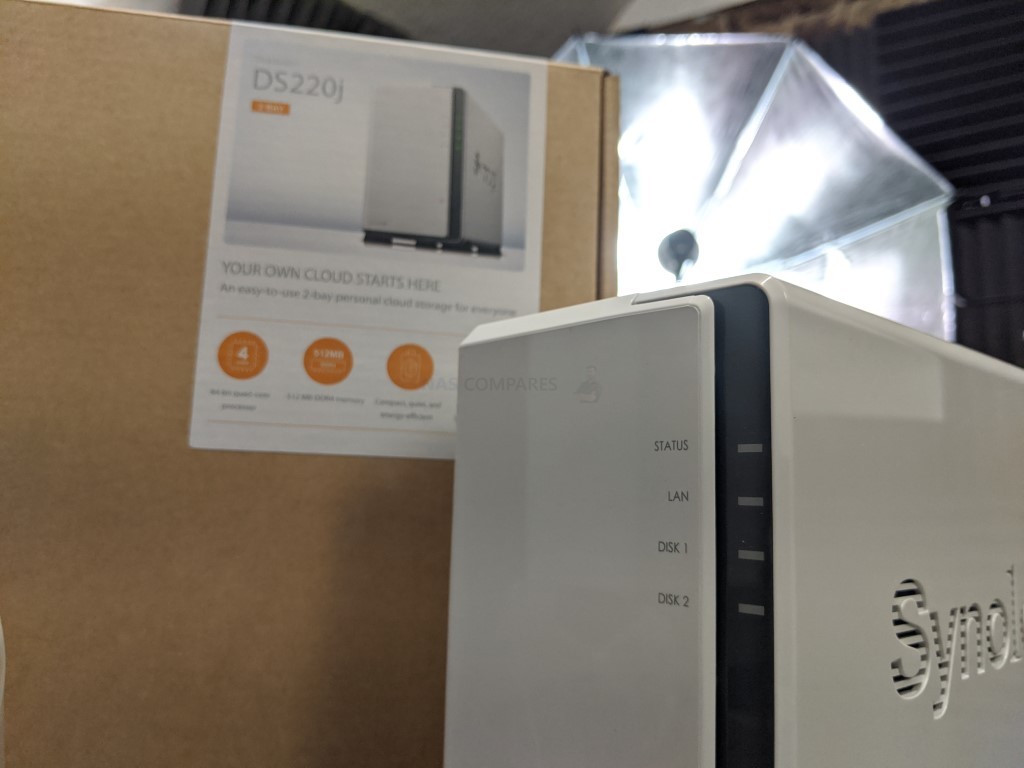
| Pros of the Synology DS220j | Cons of the Synology DS220j |
| That Realtek 4-Core CPU is FANTASTIC Value | |
| Supports latest/largest HDDs | |
| Supports ALOT of DSM 6.2 Applications | That 512MB Memory hobbles this CPU significantly on things like 4K and BTRFS |
| Synology NAS with SHR for under £125 ex.VAT | Not suitable for Plex Media Server |
| Fast Setup | |
| User-Friendly | |
| Twice as much memory as the DS119j |
A Quick Request to You – Yes, you reading this!
If you plan on buying your NAS Drive from Amazon, please use the links below for the best prices and Availability

🔒 Join Inner Circle
Get an alert every time something gets added to this specific article!
This description contains links to Amazon. These links will take you to some of the products mentioned in today's content. As an Amazon Associate, I earn from qualifying purchases. Visit the NASCompares Deal Finder to find the best place to buy this device in your region, based on Service, Support and Reputation - Just Search for your NAS Drive in the Box Below
Need Advice on Data Storage from an Expert?
Finally, for free advice about your setup, just leave a message in the comments below here at NASCompares.com and we will get back to you. Need Help?
Where possible (and where appropriate) please provide as much information about your requirements, as then I can arrange the best answer and solution to your needs. Do not worry about your e-mail address being required, it will NOT be used in a mailing list and will NOT be used in any way other than to respond to your enquiry.
Need Help?
Where possible (and where appropriate) please provide as much information about your requirements, as then I can arrange the best answer and solution to your needs. Do not worry about your e-mail address being required, it will NOT be used in a mailing list and will NOT be used in any way other than to respond to your enquiry.

|
 |
Terramaster TOS 7 Preview - Next Gen NAS Ready?
What is QNAP Planning for 2026? Round Up of the QNAP 2025/2026 Event in London
2x 10GbE to USB4 Adapter - DO YOU NEED THIS?
New Gl.iNet Beryl 7, Comet 5G SIM KVM and Flint 3e Value Router Revealed
NEW UGREEN DXP4800 PRO and DXP4800S NAS REVEALED
NanoKVM Pro Review - SO, SO CLOSE TO PERFECT...
Access content via Patreon or KO-FI





Discover more from NAS Compares
Subscribe to get the latest posts sent to your email.


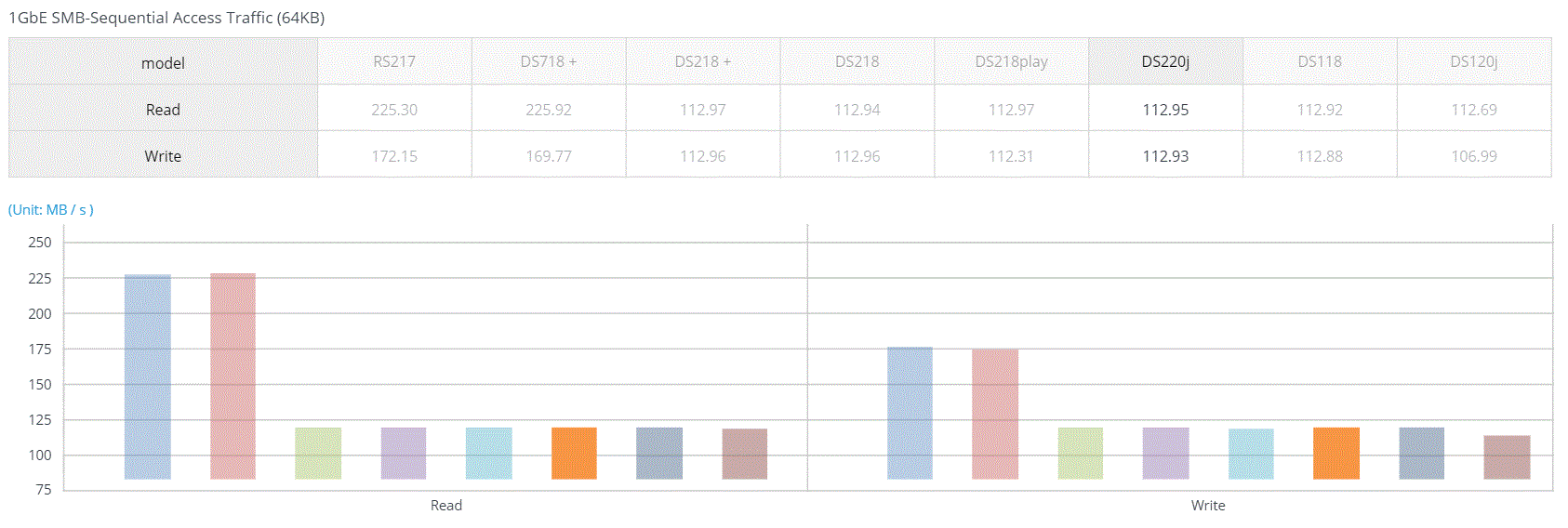




Thanks for the review, was very close to getting this purely for PLEX and 4k
REPLY ON YOUTUBE
I’ll take internal PSU any day over a brick: You get cooling for the entire thing.
Building your own with a small computer case is the way to go, if you can tell a GPU from a CPU and have the the astounding dexterity to opperate a screw driver…
REPLY ON YOUTUBE
would you say the 218+( with ram at 10gb ddr3) is better than the newer 220j ? ( 500mb of ddr4?ram )
REPLY ON YOUTUBE
I was looking for a RAID enabled NAS for a client whose use profile doesn’t include anything high-performance. The client writes (paper) books, needs a centralized and safe storage for what is, in essence, his life’s work and not much else. Client has a pc and a laptop. Client now keeps 3 or 4 versions of his stuff for ‘safety’ reasons: one on laptop, one on pc, on on dropbox and whatever… Obviously this isn’t great policy.
So.. I’m going to get him a synology ds220j NAS with two 2 TB drives in RAID and I’ll advise him to run a second one in another location in case he wants absolute security
he won’t be doing any media stuff at all.
does anyone see anything wrong with that?
REPLY ON YOUTUBE
What’s the maximum capacity for this unit? It says 2×3 tb drives but I kinda want to put larger one in
REPLY ON YOUTUBE
Hi thanks for this. All I want to do is have my movies on my nas, and play my movie files on my Samsung tv. I do have a network, but I was wondering if Im better with a nas device that has an hdmi connection directly to my tv. All of this is so overwhelming, im so confused. I could care less about watching movies on a cellphone or ipad. Seems like alot to go through just to watch my movies on my tv. Is this device still worth buying with todays technology. Any help is appreciated
REPLY ON YOUTUBE
1 GBE + 512…pass.
REPLY ON YOUTUBE
Did not show anything in reference to what’s inside or what happens when you power on, disliked
REPLY ON YOUTUBE
I’m really new to and have been researching these like crazy. I’d be mainly getting one for replacing Google Photos and sharing files first off. DS720+ really catches my eye but might get this due to price. Big differences seem to be speed and file system? If I decide to upgrade later what can I do with the DS220J and/or the drives inside?
REPLY ON YOUTUBE
I got this in hopes of using it for plex. In your review you say it is not great for it or limited. It looks like they do have a Samsung TV app for movie playback, would this suffice as a solid Plex replacement in your opinion? Do you have a budget option in mind that is capable of handling plex? Great review!